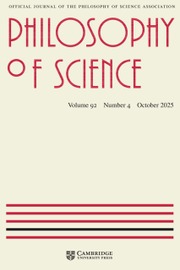No CrossRef data available.
Article contents
From Classical to Quantum Indeterminacy, and Back
Published online by Cambridge University Press: 04 September 2025
Abstract
Del Santo and Gisin have recently argued that classical mechanics exhibits indeterminacy and that by treating the observables of classical mechanics with real number precision we introduce hidden variables that restore determinacy. In this article we introduce the conceptual machinery required to critically evaluate these claims. We present a characterization of indeterminacy which can capture both quantum indeterminacy and the classical indeterminacy Del Santo and Gisin propose. This allows us to show that there is an important difference between the two: their classical indeterminacy can be resolved with hidden variables in a manner which is not possible for quantum indeterminacy.
Information
- Type
- Contributed Paper
- Information
- Copyright
- © The Author(s), 2025. Published by Cambridge University Press on behalf of Philosophy of Science Association

